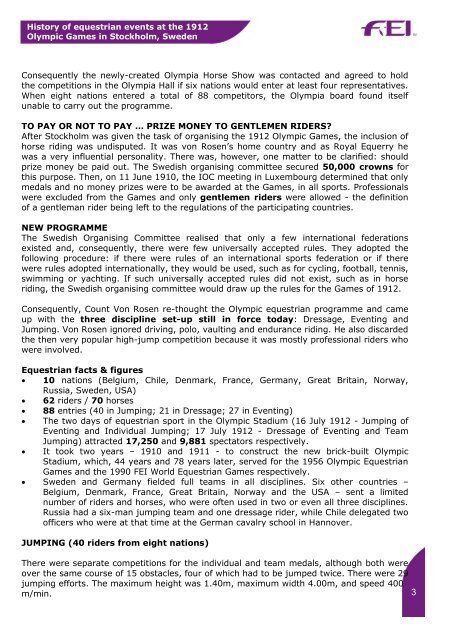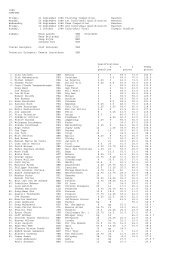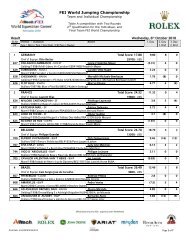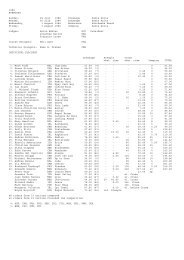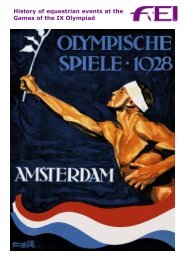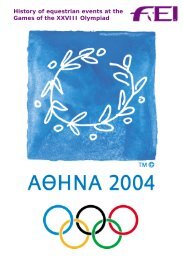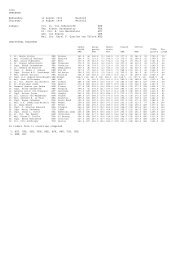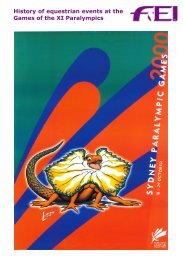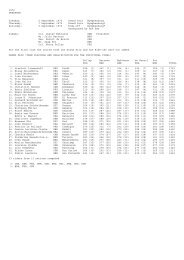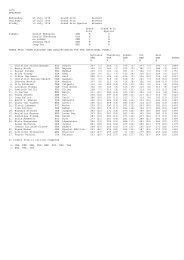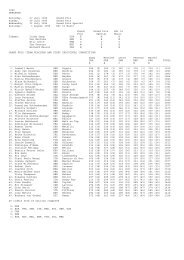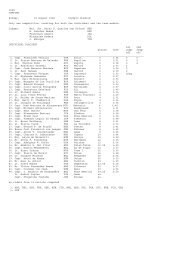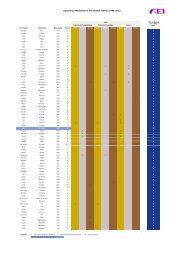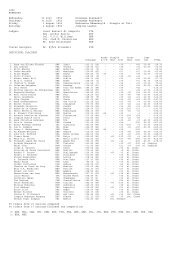History of equestrian events at the Games of the V ... - FEI History Hub
History of equestrian events at the Games of the V ... - FEI History Hub
History of equestrian events at the Games of the V ... - FEI History Hub
You also want an ePaper? Increase the reach of your titles
YUMPU automatically turns print PDFs into web optimized ePapers that Google loves.
<strong>History</strong> <strong>of</strong> <strong>equestrian</strong> <strong>events</strong> <strong>at</strong> <strong>the</strong> 1912<br />
Olympic <strong>Games</strong> in Stockholm, Sweden<br />
Consequently <strong>the</strong> newly-cre<strong>at</strong>ed Olympia Horse Show was contacted and agreed to hold<br />
<strong>the</strong> competitions in <strong>the</strong> Olympia Hall if six n<strong>at</strong>ions would enter <strong>at</strong> least four represent<strong>at</strong>ives.<br />
When eight n<strong>at</strong>ions entered a total <strong>of</strong> 88 competitors, <strong>the</strong> Olympia board found itself<br />
unable to carry out <strong>the</strong> programme.<br />
TO PAY OR NOT TO PAY … PRIZE MONEY TO GENTLEMEN RIDERS<br />
After Stockholm was given <strong>the</strong> task <strong>of</strong> organising <strong>the</strong> 1912 Olympic <strong>Games</strong>, <strong>the</strong> inclusion <strong>of</strong><br />
horse riding was undisputed. It was von Rosen’s home country and as Royal Equerry he<br />
was a very influential personality. There was, however, one m<strong>at</strong>ter to be clarified: should<br />
prize money be paid out. The Swedish organising committee secured 50,000 crowns for<br />
this purpose. Then, on 11 June 1910, <strong>the</strong> IOC meeting in Luxembourg determined th<strong>at</strong> only<br />
medals and no money prizes were to be awarded <strong>at</strong> <strong>the</strong> <strong>Games</strong>, in all sports. Pr<strong>of</strong>essionals<br />
were excluded from <strong>the</strong> <strong>Games</strong> and only gentlemen riders were allowed - <strong>the</strong> definition<br />
<strong>of</strong> a gentleman rider being left to <strong>the</strong> regul<strong>at</strong>ions <strong>of</strong> <strong>the</strong> particip<strong>at</strong>ing countries.<br />
NEW PROGRAMME<br />
The Swedish Organising Committee realised th<strong>at</strong> only a few intern<strong>at</strong>ional feder<strong>at</strong>ions<br />
existed and, consequently, <strong>the</strong>re were few universally accepted rules. They adopted <strong>the</strong><br />
following procedure: if <strong>the</strong>re were rules <strong>of</strong> an intern<strong>at</strong>ional sports feder<strong>at</strong>ion or if <strong>the</strong>re<br />
were rules adopted intern<strong>at</strong>ionally, <strong>the</strong>y would be used, such as for cycling, football, tennis,<br />
swimming or yachting. If such universally accepted rules did not exist, such as in horse<br />
riding, <strong>the</strong> Swedish organising committee would draw up <strong>the</strong> rules for <strong>the</strong> <strong>Games</strong> <strong>of</strong> 1912.<br />
Consequently, Count Von Rosen re-thought <strong>the</strong> Olympic <strong>equestrian</strong> programme and came<br />
up with <strong>the</strong> three discipline set-up still in force today: Dressage, Eventing and<br />
Jumping. Von Rosen ignored driving, polo, vaulting and endurance riding. He also discarded<br />
<strong>the</strong> <strong>the</strong>n very popular high-jump competition because it was mostly pr<strong>of</strong>essional riders who<br />
were involved.<br />
Equestrian facts & figures<br />
10 n<strong>at</strong>ions (Belgium, Chile, Denmark, France, Germany, Gre<strong>at</strong> Britain, Norway,<br />
Russia, Sweden, USA)<br />
62 riders / 70 horses<br />
88 entries (40 in Jumping; 21 in Dressage; 27 in Eventing)<br />
The two days <strong>of</strong> <strong>equestrian</strong> sport in <strong>the</strong> Olympic Stadium (16 July 1912 - Jumping <strong>of</strong><br />
Eventing and Individual Jumping; 17 July 1912 - Dressage <strong>of</strong> Eventing and Team<br />
Jumping) <strong>at</strong>tracted 17,250 and 9,881 spect<strong>at</strong>ors respectively.<br />
It took two years – 1910 and 1911 - to construct <strong>the</strong> new brick-built Olympic<br />
Stadium, which, 44 years and 78 years l<strong>at</strong>er, served for <strong>the</strong> 1956 Olympic Equestrian<br />
<strong>Games</strong> and <strong>the</strong> 1990 <strong>FEI</strong> World Equestrian <strong>Games</strong> respectively.<br />
Sweden and Germany fielded full teams in all disciplines. Six o<strong>the</strong>r countries –<br />
Belgium, Denmark, France, Gre<strong>at</strong> Britain, Norway and <strong>the</strong> USA – sent a limited<br />
number <strong>of</strong> riders and horses, who were <strong>of</strong>ten used in two or even all three disciplines.<br />
Russia had a six-man jumping team and one dressage rider, while Chile deleg<strong>at</strong>ed two<br />
<strong>of</strong>ficers who were <strong>at</strong> th<strong>at</strong> time <strong>at</strong> <strong>the</strong> German cavalry school in Hannover.<br />
JUMPING (40 riders from eight n<strong>at</strong>ions)<br />
There were separ<strong>at</strong>e competitions for <strong>the</strong> individual and team medals, although both were<br />
over <strong>the</strong> same course <strong>of</strong> 15 obstacles, four <strong>of</strong> which had to be jumped twice. There were 29<br />
jumping efforts. The maximum height was 1.40m, maximum width 4.00m, and speed 400<br />
m/min.<br />
3


